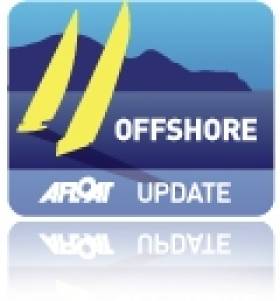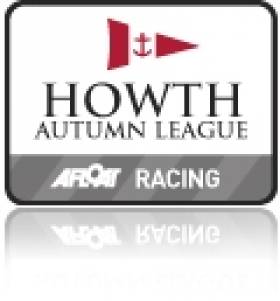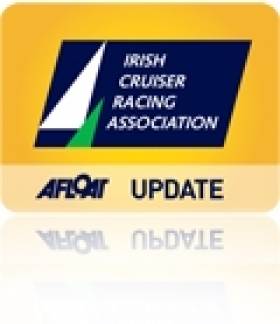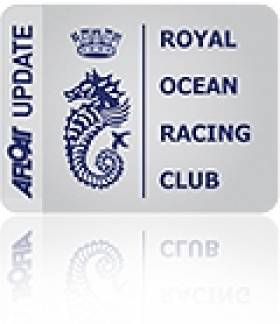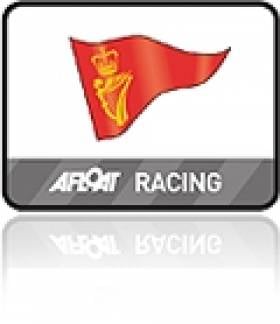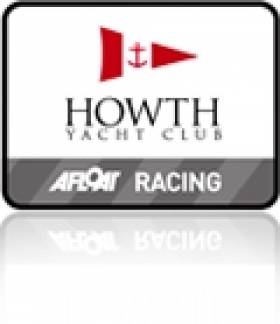Displaying items by tag: IRC
Beneteau Celebrates Success Down Under
Following the historic success of 2009 when two FIRSTs occupied the first two places in the overall IRC and ORC rankings, the 2010 race has seen another Beneteau double as two Firsts won their class in the 600-mile offshore fixture.
True to its reputation, the 2010 race took place in extreme conditions with winds reaching 45 knots and the suspense maintaine right to the end.
The well-named FIRST 45 Victoire won the race in IRC2. The FIRST 40 Paca was the winner in IRC3.
The Irish agent for Beneteau is BJ Marine.
Papillon First Home in Howth Brass Monkey Race
Delegates Debate IRC Rule Changes at Turkey Conference
Delegates considered 30 submissions for changes to IRC rules and processes. The most significant of these are:
- Rule 8.2.1 now requires that a boat holding a shorthanded certificate may not use her normal certificate for shorthanded races.
- New Rule 8.10 defines rated dimensions as maxima and minima and that a boat found during equipment inspection at an event to exceed any dimension is not in compliance with her certificate.
- Rule 21.8.1(c) is amended to limit the minimum size of headsail used by a boat rated for a single roller furling headsail.
- Rule 22.4 is amended by the deletion of old Rules 22.4.1, 22.4.3, 22.4.4 and 22.4.5. New Rule 22.4.2 now invokes Crew Number or alternatively maximum crew weight by default unless this is amended by a Notice of Race. Any event already including crew limitations in its Notice of Race will not need to do anything. However, any event which does not wish to enforce crew limitations will need to specifically say so in the Notice of Race. If a Notice of Race says nothing about crew, then IRC Crew Number or maximum weight will automatically apply. For further advice please go to the IRC website, www.ircrating.org.
Minutes of the IRC Congress and IRC Rules for 2011 will be posted on www.ircrating.org shortly.
RORC and UNCL to Forge New Worldwide Rating
The Royal Ocean Racing Club (RORC) and Union Nationale pour La Course au Large (UNCL), joint owners of the IRC rating rule, have been in discussion with the Offshore Racing Congress (ORC) about the possibility of creating a unified organisation to govern yacht ratings worldwide. This initiative to bring the world offshore rating systems together was endorsed by ISAF following its AGM in 2009 in Korea.
The intention is for RORC/UNCL and ORC to create a joint venture company which would run the existing rules, IRC and ORC and then in time, using the combined knowledge and resources, evolve new rating systems that combine the benefits of IRC and ORC to create fast, fun and seaworthy boats for unified competition all over the world.
Bruno Finzi, Chairman of ORC, working alongside Vice-Chairman Wolfgang Schaefer, are enthusiastic and confident about working with the RORC. "We appreciate the work and friendship with RORC and we believe it is finally time to get back to the IOR era and to the ORC founding spirit, when only one single rule was recognised as 'the international' rule in offshore sailing."
Chris Little, Admiral of the RORC, working with Commodore Andrew McIrvine agree that it is time to bring the development of rating systems under one umbrella.
"We have received strong support from a number of countries and potential owners to develop a rule that will allow us to recreate the international yacht racing circuit and we shall continue to work towards this goal."
Kinsale Yacht Club Announces 2011 Sovereign's Cup
Details of the 2011 Sovereign's Cup were announced at a reception at Kinsale Yacht Club, hosted by Regatta Director, Gary Horgan. The Sovereign's Cup takes place from 22nd-25th June 2011 in the outer harbour of Kinsale which prides itself with excellent sailing conditions, as well as an extensive social programme ashore.
The Sovereign's Cup was established in 1995 as a biennial event and has been a very successful and hugely popular cruiser regatta, with over 140 boats from all over Ireland and the UK competing for the prestigious Sovereign's Cup for best all round score in IRC and The Portcullis Trophy for best progressive handicap.
There are many Classes for entry; including Class 0, 1, 2, 3, 4 and two White Sails classes. Also, the Quarter Ton Class Championships will be taking place during the Sovereign's Cup, bringing many new visitors to Kinsale from the South of England and Wales in particular.
Eamonn Rohan in Blondie IV a Mills Design King 40, claimed the 2009 Sovereign's Cup as the 2009 Portcullis Trophy was awarded to Chapman / Reilly's Crazy Horse. Anchor Challenge captured Class 3-IRC and the Quarter Ton Class and was awarded the Keane's Jewellers Quarter Ton Perpetual Trophy.

The Kinsale Yacht Club committee behind the 2011 Sovereigns Cup
"We have already received a number of entries for The 2011 Sovereign's Cup in June and we will be stepping up our sponsorship and communications programme as the months advance," said Gary Horgan, Race Director. "We are very grateful to Kinsale Yacht Club, the Race Management team and all the volunteers who get involved with the organisation of the Sovereign's Cup as we are working hard to organise an excellent programme both on and off the water. We are encouraging people to start thinking about their travel and accommodation plans and are delighted that the Cork Swansea ferry will enable more sailors to access Kinsale easily from the UK," he added.
Tiger Leads Class III in Royal Cork October League (PHOTOS HERE)
What a day this Sunday's racing turned out to be. From the moment one turned the corner on to the Crosshaven road at Carrigaline there was magic in the air writes Claire Bateman. The sun was shining, the trees were resplendent in their multi colour seasonal changes and the line of cars making their way to the Royal Cork Yacht Club was non-stop. The forecast said Sunday was going to be a very nice day with lots of sunshine but nowhere did I hear anyone say anything other than winds would be light and, so it seemed, until a flag outside one of the supermarkets on the road to Carrigaline seemed to be moving pretty nicely and was a taste of things to come.

Tight racing in the penultimate race of Royal Cork's October League. Photo: Bob Bateman. Scroll down for more photos from yesterday
Classes Zero, One and 1720s got the nicest wind on the laid course to day. Race Officer Richard Leonard and his race committee in Capta Ventum, kindly provided by Pascal Healy, certainly made the best of the day. Today Richard decided on a change of format and started the 1720s first followed by Classes Zero and One together and then Class Two. He gave the fleets short courses providing very tight racing ensuring the crews had plenty of hard work and also providing very exciting viewing with a few heart-stopping moments. The 1720s, Zero and One did three rounds and Class Two did two rounds. With a northerly breeze of some 10 knots gusting to 12 and occasionally 14, it was to provide a tantalising taste of what was to come and there was no disappointment. Voices that hadn't needed to be raised at marks on previous Sundays found the necessity to make themselves heard today and the action was fascinating with hard work on the boats but a sense of great sailing exhilaration emanating from them.
Coming into race two of the day the skippers and crews had got the bit well between their teeth and were all like bucking broncos at the start line. In Class Zero there was an individual recall sounded. Jump Juice and Freya answered the call immediately and returned to restart and after some little while Gloves Off returned and while not knowing the reason why, one can only assume the helmsman perhaps was not quite convinced he had been over but then decided to return having considered it. Again the wind duly obliged and as in the first race, there were boats to the left, boats to the right and boats pretty well everywhere one looked. In Class Zero Tom Roche's Meridian from Kinsale had been performing extremely well but was slightly under
crewed today and was unlucky enough to have an incident at the weather mark in this race and after that things just did not go their way and they retired. This must have been disappointing as they had been doing so well. With Jump Juice winning the first race today and Gloves Off taking the second race and first overall to date in the series, the last day of racing next Saturday will be crucial as these races will be non discardable.
Race Officer Anthony O'Leary stood in to day for David O'Brien and the committee boat Sabrone was again kindly provided by Admiral Paddy McGlade. It was not such a lucky day wind wise inside the harbour for Classes Three and Four and White Sail 1 and 2. There was also extremely low water to day
and some of the skippers mentioned they had in fact touched rocks. Nonetheless they enjoyed good racing if at a somewhat lower pace than the competitors on the laid course.
At this point in time Class Three IRC looks like a two horse race with Tiger on 9pts followed by Bandit on 11pts. Class Four has a very similar situation with Sundancer on 9pts followed by Granny knot on 11pts. In White Sail 1 IRC Minx 111 had a good day to day with a first and second and currently has 7pts overall and the two big boats in the fleet Chancer from Kinsale and Aisha from RCYC are on 14pts each. In White Sail 2 IRC Plumbat is on 6pts overall with Phaeton on 9pts and Silk Breeze on 12pts.
And so we are coming to the final race of this exciting series. All competitors should note carefully that racing will take place on SATURDAY NEXT OCTOBER 30TH. The prize giving dinner will take place that evening at the Club House .
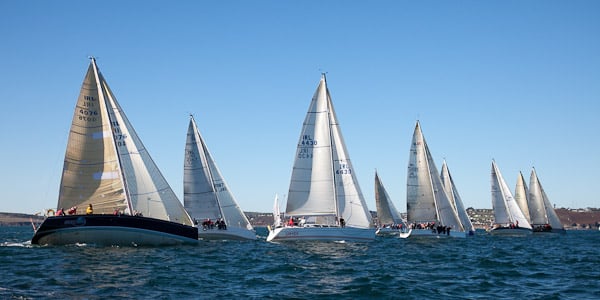
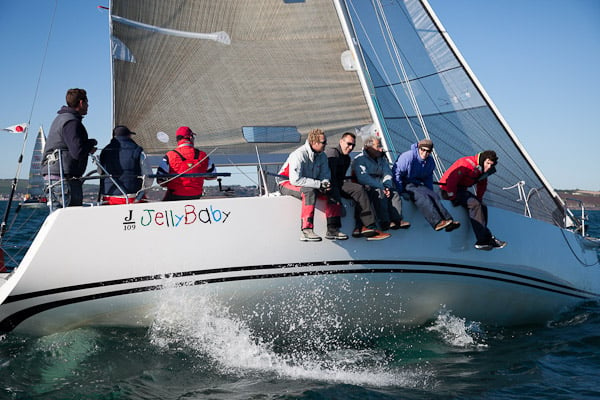




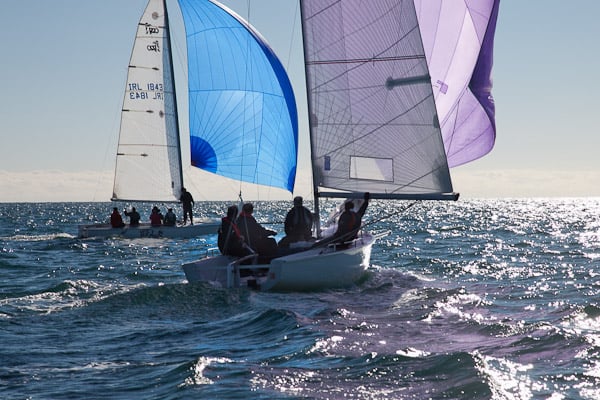
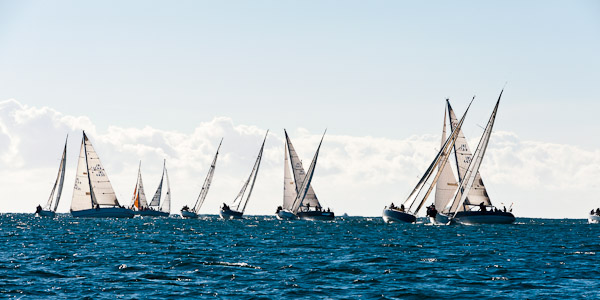
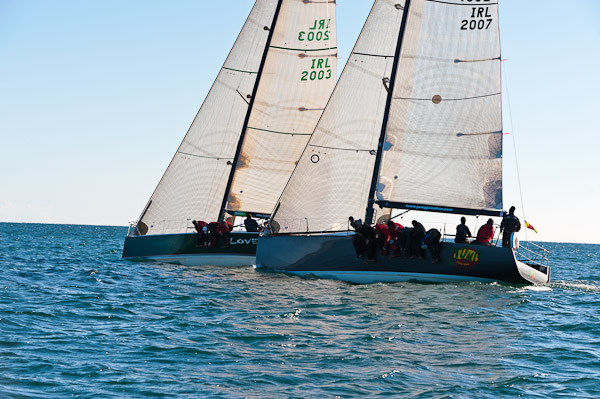
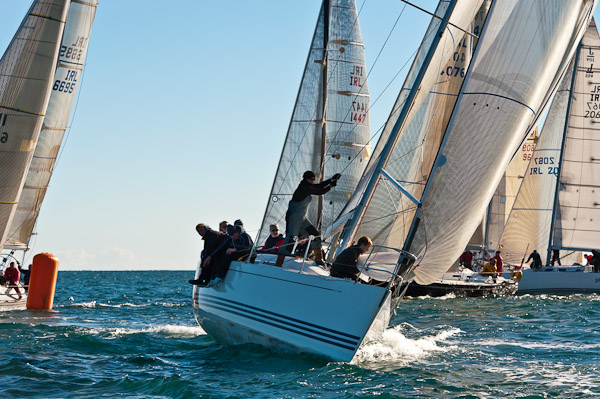
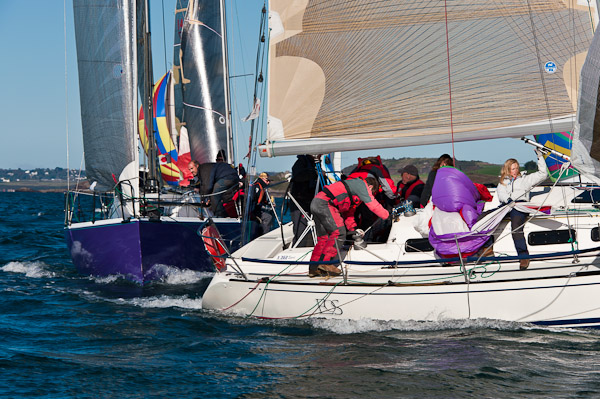


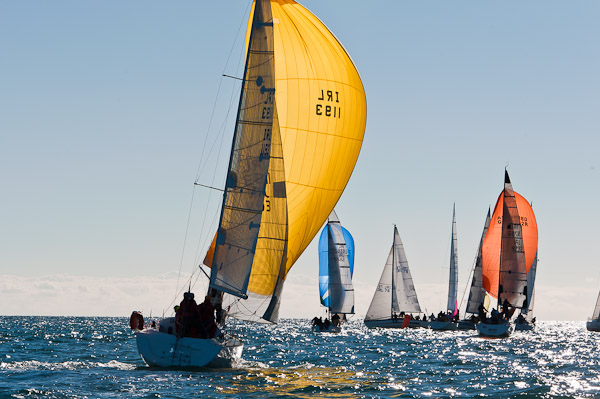
MORE OCTOBER LEAGUE GALLERY IMAGES HERE
Corby and Mills for Cruiser Racer Conference
There is always the chance when you invite two of the world's leading designers that there could be a 'blow the doors off' expose of the IRC handicap rule.....In any event next month's ICRA conference features both John Corby and Mark Mills in the Carrigaline Court hotel on a discussion panel speaking about Ireland's Rolex Commodores Cup win, an exciting topic and one which promises to be well attended. Make sure of your place at the conference. More HERE.
Ideal conditions to end Howth Yacht Club's 2010 Autumn League
This year's Howth Yacht Club Autumn League – sponsored by WD-40, Crystal Holidays and The Food Room – ended on a high note from a competitive viewpoint, with moderate northerly winds and plenty of sunshine to complete the series with two back-to-back sailing races on all three courses.
While a number of pre-racing favourites and series leaders came through to take the honours in their respective classes, there were a few anxious moments on some boats, with some indifferent results on the final day.
No such concerns were on board Pat Kelly's Storm, with a win in the first race sealing the series in which their discard was a 2nd place. While Ross McDonald's Equinox challenged hard and won the second race of the day, it was never going to be enough so the runner-up spot was their reward. The same two boats also shared the day's spoils in the WD-40 mini-series and the overall placings were identical to the IRC, although a double success on ECHO meant Equinox enjoyed overall honours in both events ahead of their main rival.
The day didn't start well for Class 2 favourite Kinetic with an OCS in the first race which was won by the narrowest of margins by MiniMumm (Cobbe/McDonald) ahead of Impetuous (Noonan/Chambers). That aberration was put to rights in the second race with the Colwell/Murphy crew getting the nod over Impetuous, a result that wrapped up the IRC title with six points to spare over Dave Cullen's King One. A second and a first on ECHO were sufficient to give Impetuous overall victory in that division to add to 3rd overall on IRC.
Class 3 ended as it started with Vince Gaffney's Alliance to the fore. Winning the first race ahead of Kevin Darmody's Gecko and then swapping places in the second was more than enough to maintain the overall lead and win on IRC by four points from the principal rival. The ECHO honours went to Malahide boat Tobago (Tom Ray & Others) which tied with Gecko on points and won on better discard.
Trinculo (Michael Fleming) and Bite the Bullet (Colm Bermingham) won the two races in Class 5 on both ECHO and IRC, the upshot of which was overall success on ECHO for the Bermingham crew by three points over the Boyle's On the Rox. On IRC, a third and a second put Flashback on level terms with Bite the Bullet on points but getting the nod on countback.
Stephanie Ennis and Windsor Laudan will remember the 2010 Autumn League with some fondness, as their debut series in the veteran Shamrock Demelza was outstandingly successful in Class 5. The smallest boat in the fleet was competitive throughout the series and a double win on ECHO just cemented their dominance of the class, with a healthy 8-point margin over runner-up Harmony (D&H Toomey). Harry Byrne's Alphida, with a first and second on the final day, emerged top of the IRC rankings by two points ahead of Joe Carton's Voyager.
On the one-design course, Jay Bourke's Northside Dragon from the Royal St.George YC, experienced its worst day of the series, with a 9th and a 4th, yet discarding that last
place in the opening race was enough to take the Etchells title by a single point from Simon Knowles' Jabberwocky. The day's two races were won by Robert Dix's Glance and Dan O'Grady's Kootamundra Wattle respectively.
Mossy Shanahan, helming Scandal, enjoyed a good win in the first J24 race with a minute to spare over national champion Flor O'Driscoll in Hard on Port although the latter had the last laugh by reversing the order in the final race. Howth's Jibberish (Fergus O'Kelly et al) did not have a good day but even two third places were enough to head the small fleet by one point from Scandal.
A double success for Puppeteer champion Garrett May and crew on Ibis was no doubt satisfying but it was never going to be enough to deny Harlequin (Clarke/Egan) unless the early pace-setter faltered badly. Finishing right on the tail of the double-winner was all they needed to take the crown by a comfortable 8-point gap. On handicap, another double success, this time by Flycatcher (Wright/Dillon), moved them up the rankings to 2nd overall, one point behind a delighted Harlequin crew taking those honours too.
After a slow start, Emmet Dalton's Klipbok emerged at the top of the Squib fleet yet again but it required two straight wins and two average results by the series leader Kerfuffle (Craig/Raune) to achieve that result. A double handicap success for Rechaun (C.Kellett) did not spoil the party for Emer Harte's Puffin, handicap winner by a single point from Phil Merry's Shadowfax.
It was all change on the Seventeen's course, with two firsts giving the overall honours to Ian Malcolm's Aura, three points clear of the early leader Rita (Lynch/Curley). A first and a second on handicap were also enough for Aura to enjoy a double success, with Derek Bothwell's Sheila taking the runner-up spot.
Crotty Stays on Top in 1720s
The sun may have been missing from the scene this morning at Crosshaven and the skies may have been dark and overcast but the wind was blowing, the buzz was very definitly in the the air and the spring was in every sailors'step as they arrived in their droves to set forth on the second day of the O'Flynn Exhams Autumn League at the Royal Cork Yacht Club writes Claire Bateman. Photos from race two on the gallery click HERE
The wind was gusting some 26 knots on the marina but by the time the boats had reached the comittee boats for the start of racing the east wind had moderated to some 10/12 knots and later went north easterly, was obviously going to provide a good day of sailing. The two Race Officers had put their minds together on the courses and decided to sail both fleets within the harbour and this proved to be an outstanding success. Race Officer David O'Brien was today on Classes Three, Four and Whitesail one and two and his boat "Sabrone" was kindly provided by Admiral Paddy McGlade who was on board for the racing. Richard Leonard's committee boat "Capta Ventum" was kindly provided by Pat Healy who was also on board to watch the day's events unfold.

Tight handling in the second day of Cork's Autumn League races. Photo: Bob Bateman. More on the gallery HERE
There are exceptionally high spring tides at the moment and this exercised the minds of the all sailors to keep out of the strong tide and on the other hand to avoid going aground on any of the banks around the harbour. In this regard the one casualty was Peter Webster's Thistle from Class Four which went aground and spent some time waiting for the incoming tide.
The tight courses and the racing tide coupled with the sufficient breeze made for close racing. John Crotty was a very happy man sailing the 1720 Two 2 Tango and winning the class for the second week in a row. Class One is of course a very competitive class and there was close racing between the 4 X332s. In Class Two it was good to see Bad Company and wicked so close together but the day in Class Two belonged to Shane Statham of Waterford Harbour in Slack Alice who ended first overall in IRC and ECHO. In Whitesail 2 Clive Doherty had an excellent day winning IRC1 and Ernie Dillon received a tumultous reception when his name was called out in the same class for wining ECHO.
The combination of the fleets racing in the magnificent harbour today added greatly to the buzz with yachts flying everywhere and the fleets moving around with the greatest of ease. Some were up off Cobh while others went to a laid mark off the Aghada shore and Whitesaill one and two were given a course which should have taken in the OFE2 buoy outside the harbour but given the fear would lighten even further race officer David O'Brien decided to shorten the course so the white sail fleets hada somewhat easy day of sailing and returned early to the warmth of the club house. It was certainly a huge success on the part of the race officers and added greatly to the enjoyment as was heard from the sailors in their apés sail get totether. There were three protests from the racing today but one was withdrawn and the other two were resolved amicably so all was well and the prize giving presided over by Aeibhín Cahalan of O'Flynn Exhams brought a fitting finish to the day.
Blue Velvet Wins in Howth Yacht Club
HOWTH YACHT CLUB. TUE + SAT SERIES 3 (RACE) 20/07/2010 17 Footer SCRATCH: 1, Rita Lynch/Curley; 2=, Aura I Malcolm; 2=, Leila R Cooper; 17 Footer HCAP: 1, Echo B & H Lynch; 2, Rosemary Curley/Jones; 3=, Aura I Malcolm TUESDAY SERIES 3 (RACE) 20/07/2010 Puppeteer SCRATCH: 1, Blue Velvet C & K Kavanagh; 2, Yellow Peril N Murphy; 3, Enigma D Butler; Puppeteer HPH: 1, Apollo M & D Patton; 2, Nefertari Morgan/Murray; 3, Mr. Punch NiBhraonain/Wilson; Squib SCRATCH: 1, Chatterbox J Kay; 2, Arctic Fox G Barry; 3, Kerfuffle J & H Craig; Squib HPH: 1, Arctic Fox G Barry; 2, Chatterbox J Kay; 3, Shadowfax P Merry; Etchells SCRATCH: 1, Kootamundra Wattle O'Grady/Reilly; 2, Fetching Quinn/O'Flaherty; 3, Jabberwocky S Knowles; SB3 SCRATCH: 1, Investwise D Quinn; 2, Einstein's Nightmare J Wenski; 3, Sin a Bhuifl Guinness/Costigan




























